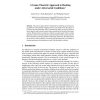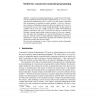112 search results - page 9 / 23 » Power and the limits of reactive agents |
DATE
2009
IEEE
14 years 1 months ago
2009
IEEE
—The sustained push for performance, transistor count, and instruction level parallelism has reached a point where chip level power density issues are at the forefront of design ...
IFIPTCS
2010
13 years 4 months ago
2010
Abstract. We present a game-theoretic framework for modeling and solving routing problems in dynamically changing networks. The model covers the aspects of reactivity and non-termi...
AAIM
2005
Springer
13 years 8 months ago
2005
Springer
The idea of active networks has been emerged in recent years to increase the processing power inside the network. The intermediate nodes such as routers will be able to host mobile...
POPL
1990
ACM
13 years 10 months ago
1990
ACM
Abstract. Concurrent constraint programming is a simple but powerful framework for computation based on four basic computational ideas: concurrency (multiple agents are simultaneou...
AAAI
1994
13 years 8 months ago
1994
We propose a propositional language for temporal reasoning that is computationally effective yet expressive enough to describe information about fluents, events and temporal const...


